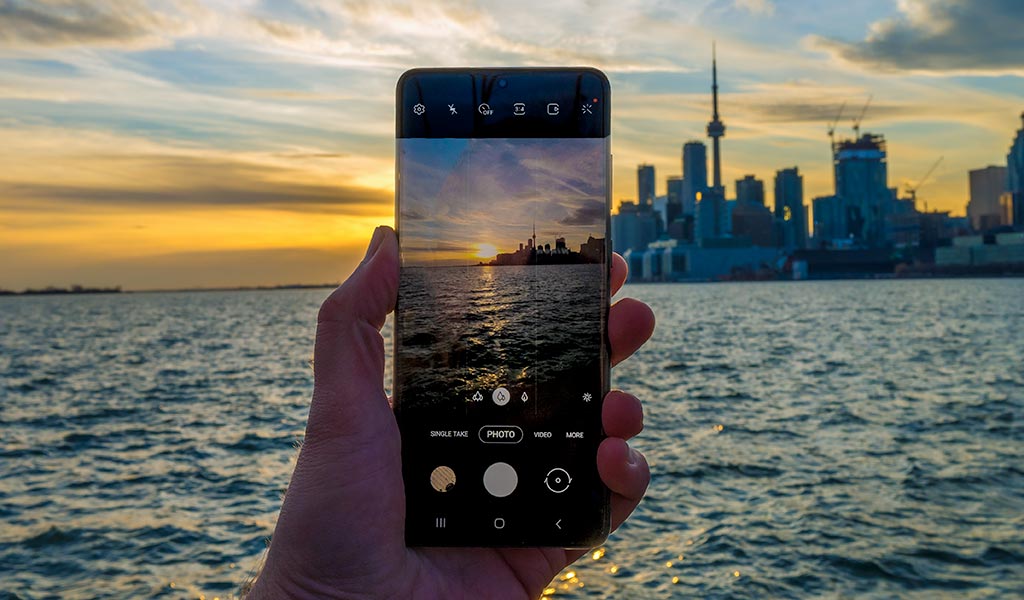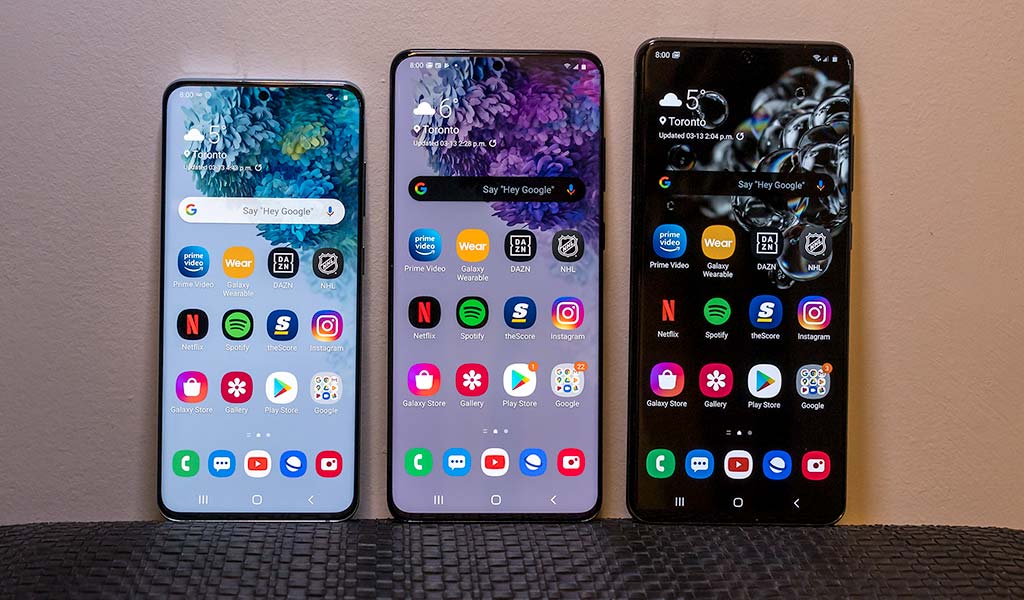
The Samsung Galaxy S20 5G comes in three different models, all of which offer their own advantages that may help you decide the best option for you. Just like it did last year with the Galaxy S10 devices, Samsung has done the same thing with the Galaxy S20. Only this time around, the similarities are numerous, and the differences mostly come down to size and camera performance.
You can check out my full reviews of the Galaxy S20 and S20+ and the Galaxy S20 Ultra 5G here on the blog. That all three are quality devices is obvious, so you’re not likely to make a poor choice, only that you want your choice to feel some measure of perfection.
Setting them apart
The obvious difference from the start is size. The Galaxy S20 Ultra has a monstrous 6.9-inch Dynamic AMOLED. The Galaxy S20+ is a bit smaller at 6.7-inches and the S20 is the smallest at 6.2-inches. Compare them in size and weight, and the S20 is, by far, the easiest to wield one-handed. The S20 Ultra is like having a small tablet in your pocket, making it easy to appreciate watching video on it.
All three phones now have flatter displays, as Samsung seemingly moves away from the curved edges it championed for years. The headphone jack is also gone, marking the first time a Samsung flagship cut that out. Bear in mind that the company also doesn’t include a USB-C-to-3.5mm adapter to use wired headphones. You’ll have to get your own.
Under the hood, the phones use the same processor, and offer similar levels for RAM and internal storage. There are a few exceptions — the S20 only comes with 128GB of storage, whereas the other two come in either 128GB or 512GB options. RAM is either 8GB for the S20, or 12GB for the others. All three do have microSD card slots you can expand up to 2TB, so memory expansion is still available.
I’ll touch on the camera differences further down, but as you might expect, the respective batteries in these phones are commensurate with their size. The S20 Ultra has a large 5000mAh battery inside, compared to 4500mAh for the S20+ and 4000mAh for the S20. All of them have excellent battery life.

The camera
I go into the respective cameras in a lot more detail in the reviews, but suffice it to say, the gap between them isn’t as huge as you might think. The S20 Ultra’s notable feature set includes a 108-megapixel camera, 100x Space Zoom, 8K video recording and a real telephoto lens that actually has optical zoom.
Of those features, the S20+ and S20 both offer 8K video recording, but that’s not something to feel really excited about at this stage. Right now, 8K TVs are far from ubiquitous, as is any content available at that resolution. While you can splice a 33-megapixel still image from an 8K clip, I find shooting in 4K at 60fps far more serviceable.
The 108-megapixel camera is actually a 12-megapixel sensor using pixel binning. It splits each pixel at a 9:1 ratio to not only make images larger, but also capture more detail, especially for cropping. Samsung did put in a significantly larger image sensor in the S20 Ultra, and it is capable of taking excellent photos, but so are the other two. I will say, however, that the Ultra’s telephoto lens is better than the others because it actually uses 4x optical zoom, rather than a crop factor, like the S20+ and S20 do.
The 100x Space Zoom is of little use. Not only are images terribly pixilated and dull at that range, there’s no way to get anything good out of them. Even the 30x zoom is suspect, though quality is certainly better. At 10x zoom, however, quality gets much better. All three phones offer 10x and 30x zoom, so it’s really only Space Zoom that separates them, and that doesn’t count for much, in my opinion.
Otherwise, the camera options and user interface are identical. New modes, like Single Take and Pro Video, are accessible on all of them. The S20 doesn’t have a depth sensor like the S20+ does (and the Ultra has, too), which is a drawback, but not an awful one.

Performance
Here, too, the phones are pretty similar. You can access the superb 120Hz refresh rate for the screen by going to Settings>Display>Motion smoothness. It smooths out navigation across Samsung’s UI One Android overlay, and is something you will appreciate over time.
These are robust handsets capable of running just about anything you want. Streaming media and gaming are, more or less, the same, save for size. I liked the large S20 Ultra display for video and work productivity, yet found the experience easier to handle on the S20+.
I can’t say the same for the ultrasonic fingerprint sensor, which needs work on all three. It was a little too unresponsive and slow, so opted to stick to a PIN instead. Your experience might vary, but I’m not sure it will by any great measure.
Note that, while this trio of phones offers 3400 x 1080 resolution, you can’t use that and 120Hz at the same time. It’s a restriction applying to them all. Picking between them, I always chose 120Hz because 2400 x 1080 still looked just fine to me. The only time I would consider maybe switching back was if I was watching a movie in HDR on Netflix or Prime Video.
Call quality is also pretty much the same. I never noticed anything uniquely different from one to the other while talking to people. Same with audio quality from the speakers or over Bluetooth.
Battery life
The size of the phone’s battery kind of goes hand-in-hand with how long it lasts with these phones. Samsung engineered the batteries to be efficient, and while 120Hz refresh does sap it a little faster, you should last a full day without worry.
Each one comes with a 25W charger in the box, that can go from empty to full in about an hour. The S20 Ultra has a slight edge in that it can also support 45W chargers. I wasn’t able to test one, so don’t know that it’s that much faster. If you care about that a lot, it is a differentiator between them.
They also equally support wireless charging, and Wireless PowerShare to charge other devices on their backs. In both cases, anything supporting the Qi wireless standard is compatible.
5G connectivity
I didn’t get the chance to test any of these devices on a 5G network. They were nice and quick on current 4G LTE networks, but they are very much ready for what’s coming next. Canada’s major carriers have confirmed their respective 5G networks are going live this year in some major cities, and you would be prepared with any of the S20 models.
Protection
I can’t stress enough how badly these phones need a case — and a screen protector on top of that. They are delicate and fragile. Sure, they do have water-resistance, but it’s an accidental fall that is of greater concern. If you do go with any one of these phones, prioritize getting a case and screen protector to go with it. You won’t be sorry you did.
Making a choice
Personally, I found the S20+ to be my favourite of the three. It struck the right balance between size, functionality and camera performance. However, I did also take a real liking to the S20, finding it highly portable for its screen size. The Ultra, on the other hand, was a stellar device — only its unique features and characteristics didn’t set it apart enough.
That was my take, but you may have a different feel for them. That’s why I also highly recommend you take a chance to see and feel them first. These are premium models, and while there isn’t a bad choice between them, there may be one that feels right.
Check out all the Samsung Galaxy S20 devices available now.



